![]() Projects
Projects
Multi-Piece Molding
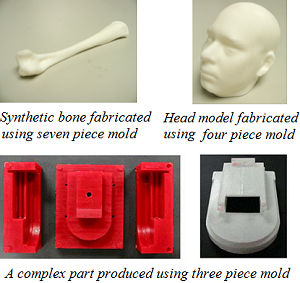 Multi-piece molds can be used to make complex-shaped parts that cannot be made by two-piece molds. Multi-piece molding overcomes the restrictions imposed by traditional molds by having many parting directions. These molds have more than one primary parting surface and consist of more than two mold pieces or subassemblies. Each of these mold pieces has a different parting direction. This freedom to remove the mold pieces from many different directions eliminates the undercuts produced by two-piece molds. Recently, we have developed a multi-piece mold for realizing drive mechanisms of a micro air vehicle (MAV). This novel molded compliant mechanism converts the rotary motion of the motor into the oscillatory flapping motion of the wings. The final mold drive mechanism weighs only 1.6g. We have demonstrated successful flight and steering capabilities of a MAV using this drive mechanism.
Multi-piece molds can be used to make complex-shaped parts that cannot be made by two-piece molds. Multi-piece molding overcomes the restrictions imposed by traditional molds by having many parting directions. These molds have more than one primary parting surface and consist of more than two mold pieces or subassemblies. Each of these mold pieces has a different parting direction. This freedom to remove the mold pieces from many different directions eliminates the undercuts produced by two-piece molds. Recently, we have developed a multi-piece mold for realizing drive mechanisms of a micro air vehicle (MAV). This novel molded compliant mechanism converts the rotary motion of the motor into the oscillatory flapping motion of the wings. The final mold drive mechanism weighs only 1.6g. We have demonstrated successful flight and steering capabilities of a MAV using this drive mechanism.
For more details please click here.

Drive mechanism for micro-air vehicle molded in using mesoscale multi-piece molding
![]()
In-Mold Assembly for Creating Articulated Structures
We have shown that in-mold assembly can be used to create plastic products with articulated joints. In-mold assembly eliminates the need for post-molding assembly and reduces the number of parts being used in the product, hence improving the product quality. We have developed proven mold design templates for realizing revolute, prismatic, and spherical joints. We have also developed proven mold design templates for realizing joints found in compliant mechanisms.
For more details please click here.
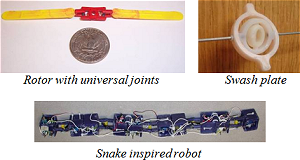
Examples of articulated structured molded using in-mold assembly
![]()
In-Mold Assembly at the Mesoscale
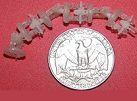 |
In-mold assembled six degree of freedom finger inspired robot. |
![]()
Injection Molding of Highly Filled Polymers
 |
Injection molded heat exchanger fabricated using filled polymer composite. |
![]()
Hierarchically-Structured Multifunctional Polymer Composites
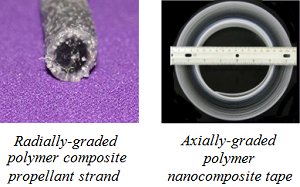 The integration of microscale and nanoscale fillers can enhance mechanical, electrical, and thermal properties from the interaction of the fillers across multiple length scales. We are currently characterizing how these properties transition across length scales and compositions in order to optimize the multifunctionality of these materials for applications such as electrically-conductive impact-resistant panels for marine structures and thermally-conductive adhesives for space structures such as in the figure below.
The integration of microscale and nanoscale fillers can enhance mechanical, electrical, and thermal properties from the interaction of the fillers across multiple length scales. We are currently characterizing how these properties transition across length scales and compositions in order to optimize the multifunctionality of these materials for applications such as electrically-conductive impact-resistant panels for marine structures and thermally-conductive adhesives for space structures such as in the figure below.
![]()
Folding Wing Ornithopter
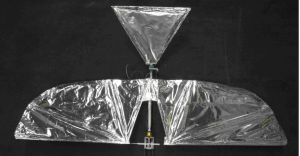 Ornithopters are flying vehicles that use flapping wings to create lift and thrust. By creating an ornithopter that uses compliant wings, greater realism in flight can be achieved. When wings are folded during the upstroke of the flapping motion, their surface area is reduced, thus lowering negative lift production. By passively unfolding the wings during the downstroke, surface area is maximized, thus producing a positive lift gradient between the upstroke and downstroke. This additional lift production can be used to augment the aerodynamic lift that is produced by passing fast moving air over the wings, thus allowing very slow forward flight speeds while maintaining payload capacity and controllability of the ornithopter.
Ornithopters are flying vehicles that use flapping wings to create lift and thrust. By creating an ornithopter that uses compliant wings, greater realism in flight can be achieved. When wings are folded during the upstroke of the flapping motion, their surface area is reduced, thus lowering negative lift production. By passively unfolding the wings during the downstroke, surface area is maximized, thus producing a positive lift gradient between the upstroke and downstroke. This additional lift production can be used to augment the aerodynamic lift that is produced by passing fast moving air over the wings, thus allowing very slow forward flight speeds while maintaining payload capacity and controllability of the ornithopter.
For more details please click here.
![]()
Functionally Graded Materials (FGMs)
Optimal application of composite structures often requires that properties be distributed in a gradual manner rather than in abrupt transitions in order to mitigate stress concentrations and enhance transport processes. We have pioneered a variety of commercial processes for FGMs, such as nano-enhanced pressureless sintering of graded metal-ceramic processes and twin-screw extrusion of polymer composites that can be seen in the figure below. In situ and a posteriori techniques have also been developed to characterize the gradient architecture and associated property distributions. Modeling tools are available for designing FGMs using these processes in a variety of applications, ranging from armor panels to rocket motors. Our graded materials are also being used for combinatorial development of new polymer composites with multiple fillers.
![]()
Gelcasting of Bioinspired/Biomedical Structures
The manufacturing of bioinspired and biomedical structures require new technologies that enable the more complex geometries and material distributions found in natural systems to be transferred to synthetic structures. We have been able to utilize gelcasting technology for ceramics and metals combined with a pore-inducing technique based on carbon burnout to create geometrically complex bioinspired/biomedical structures, such as the replamineform inspired bone structure using multi-piece molding technology. These structures can be easily mass-produced with a variety of materials distribution consisting of metals and ceramics and in a variety of geometric configurations.
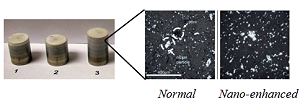
Nano-enhanced pressurelessly-sintered graded metal-ceramic cylinders with significant
porosity reduction
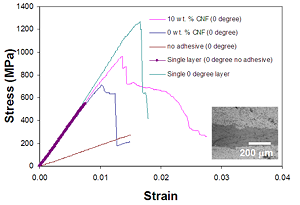
Improved laminated composite using nano-enhanced electrically-conductive adhesive
![]()
